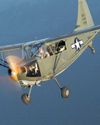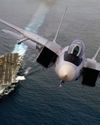Prøve GULL - Gratis
FM-2 Wildcat action in the battle of Leyte Gulf
Flight Journal
|November - December 2022
IN MID-1943, the Grumman Aircraft Corp. began to deliver the F6F Hellcat-its latest and greatest fighter-to the U.S. Navy. It was fast, maneuverable, heavily armed and armored. It was built "Grumman tough" and soon earned the nickname "Ace Maker." As a replacement for its little brother, the F4F Wildcat, the Hellcat was everything the F4F wasn't.

During this period, the Navy began to use a one-two-punch technique against the Japanese. First, it used a full fleet and light carriers to attack Japan's warships and other vessels landbased airstrips, and troop concentrations. At the same time, a combination of TBM/TBF torpedo planes and Curtiss Helldiver bombers destroyed targets of opportunity, and the Hellcats were unleashed on Japan's aircraft.
The second punch" was delivered in the form of small jeep carriers” that moved in quickly and established air superiority and close air support for ground troops as the larger, faster carriers moved ahead and pushed the Japanese farther north. These smaller carrier vehicle escorts CVEs) were aided by the F4F Wildcat.

Following the Hellcat’'s success in the Pacific, Grumman was committed to increased production, so Wildcat and Avenger production was transferred to the Eastern Aircraft Division of General Motors. While being produced by General Motors, the F4F Wildcat was given anew name and anew set of claws: the FM-2 Wilder Wildcat” carried alarger engine and less gross weight, so the stubby cat became a real tiger. And during the battle of Leyte Gulf, in the hands of one particular pilot, it tore into Japanese forces with a vengeance!
Joe McGraw relates:
Denne historien er fra November - December 2022-utgaven av Flight Journal.
Abonner på Magzter GOLD for å få tilgang til tusenvis av kuraterte premiumhistorier og over 9000 magasiner og aviser.
Allerede abonnent? Logg på
FLERE HISTORIER FRA Flight Journal

Flight Journal
ELLIPTICAL ELEGANCE
Flying and evaluating the Seafire Mark III
4 mins
November - December 2025

Flight Journal
IRON DOG
Fighting the Pacific and the P-39 at the same time
14 mins
November - December 2025

Flight Journal
Fighter Pilots: A Warrior Clan
TAKE A HARD LOOK at the two young men in these photos. Do they look as if they were bent on killing one another? On the left we have a young, unknown enlisted Japanese pilot standing in front of a Nakajima Ki-27 \"Nate,\" one of Japan's earliest monoplanes that led to the much vaunted Zero.
3 mins
November - December 2025

Flight Journal
KEN WALSH THE FIRST CORSAIR ACE
Medal of Honor pilot's combat adventures
12 mins
November - December 2025

Flight Journal
Big Chief's Little Chief
Thunderbolt action with the Wolf Pack
11 mins
November - December 2025

Flight Journal
ENEMY PILOTS SPEAK Voices from the other side
All too often American students of air warfare forget that enemy aircraftwhether Messerschmitts or MiGs-were flown by human beings with the same motivations and traits as Allied airmen. More often than not, the only difference between friend and foe was the paint on the airplane and where they landed. Therefore, we've assembled a variety of accounts from WW II Axis fighter pilots, men who were more than simply targets.
11 mins
November - December 2025

Flight Journal
FLYING THE FW 190
A legend gets checked out in the Butcher Bird
15 mins
November - December 2025

Flight Journal
DOUBLE-THEATER ACE
The fearless missions of legendary fighter pilot Col. John D. Landers
12 mins
November - December 2025

Flight Journal
WARBUG IN THE PACIFIC
Surviving combat in a Stinson OY-1/L-5
10 mins
September - October 2025

Flight Journal
WINGS OF THE FLEET
Celebrating the U.S. Navy's 250-year legacy
9 mins
September - October 2025
Translate
Change font size

